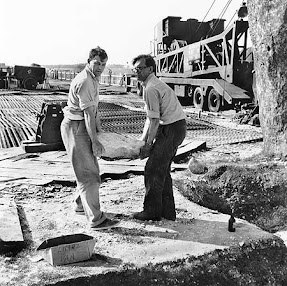Thanks to Tony for a number of comments recently about the bluestone lithics in the Stonehenge landscape. There are -- by common consent -- thousands of them, dug up and revealed in Stonehenge digs, in field walking exercises, and in excavations elsewhere in the Stonehenge landscape. Most of them are ignored or thrown away, and Ixer and Bevins choose not to take them seriously unless they are clearly related to known bluestone orthostats -- so that neatly eliminates anything "inconvenient"............
See Julian Richards, 1990 -- The Stonehenge Environs Project, EH, London
But it isn't that easy. Stone and Richards, in various publications, refer to a "wide distribution" of fragments of dolerite, rhyolite and volcanic ash, and they refer to many rock types that are not represented in the bluestone orthostat assemblage. They refer to "unknown" rhyolites, ashes, dolerites and quartzites. Mostly they label the bluestone finds as flakes, fragments, slabs, hammerstones or tools -- demonstrating an unwillingness to contemplate the presence of bluestone boulders, cobbles or pebbles that might have nothing to do with human activity.
And the things that are all too easily referred to as "tools" may indeed not be tools at all, but perfectly natural small bluestone erratics such as we might find in any degraded glacial deposit:
Here is another old photo from a 1902 excavation at Stonehenge, again assumed to show "sarsen stone and flint implements" -- with no apparent awareness that some might simply be glacial erratics......
https://www.silentearth.org/restorations-at-stonehenge-2/
In the photographic record of the Atkinson and earlier digs at Stonehenge, over and again we see packing stones and small boulders that are simply ignored and thrown onto spoil heaps. Appalling! Watch this space.........
STONEHENGE EXCAVATIONS 2008 Timothy Darvill, VPSA, and Geoffrey Wainwright, PSA




5 comments:
One of the things that astonishes me, apart from the tendency of the archaeologists, en masse, to ignore "the elephant in the wider Stonehenge landscape", is for notable " celebrity archaeologists" such as Phil Harding, Honorary PhD, University of Southampton, to refuse to apply his own brainpower to this whole glaciation hypothesis question. It saddens me. He seems to be another one associated with both the Stonehenge wider landscape/ Salisbury P!ain [ e.g. the recent initial excavation at Boles Barrow] and also as a former employee for many years of the Wessex Archaeology company, to not be brave enough to stand up, use his skills and intelligence, and consider seriously the merits for accepting the case for glaciation based upon what his eyes in the excavation trenches tell him (and others at, e.g. Wessex Archaeology).Is the Human Transport notion so untouchable?? If so, for goodness sake WHY??
Thankfully, there will be a new generation of environmental archaeologists and earth scientists and others growing up as I type, who are NOT wedded to this ruling hypothesis straight jacket and will go forth and demonstrate through application that the glaciation hypothesis holds all the aces.
On the subject of modern - day archaeologists who are actively involved with Salisbury Plain, I have just noticed that Richard Osgood, the M.O.D. archaeologist, was awarded an M.B.E. in 2021. I'd encourage him to address this issue of the glaciation evidence waiting to be found on Salisbury Plain. Some of you may remember he recently led an Operation Nightingale team of army veterans in the re - excavation of the notable Boles Barrow on the Plain and physically in Heytesbury Parish (where William Cunnington is buried in its graveyard). You never know, Richard, a knighthood may await you!
A much later comment ( February 18th 2924) now from me......after taking a look at Julian Richards' 1990 Stonehenge Environs Project publication, I note it states that HILARY HOWARD analysed the bluestone fragments.
Assume that might be 2024........... yes, Hilary Howard pops up in various publications........
Post a Comment